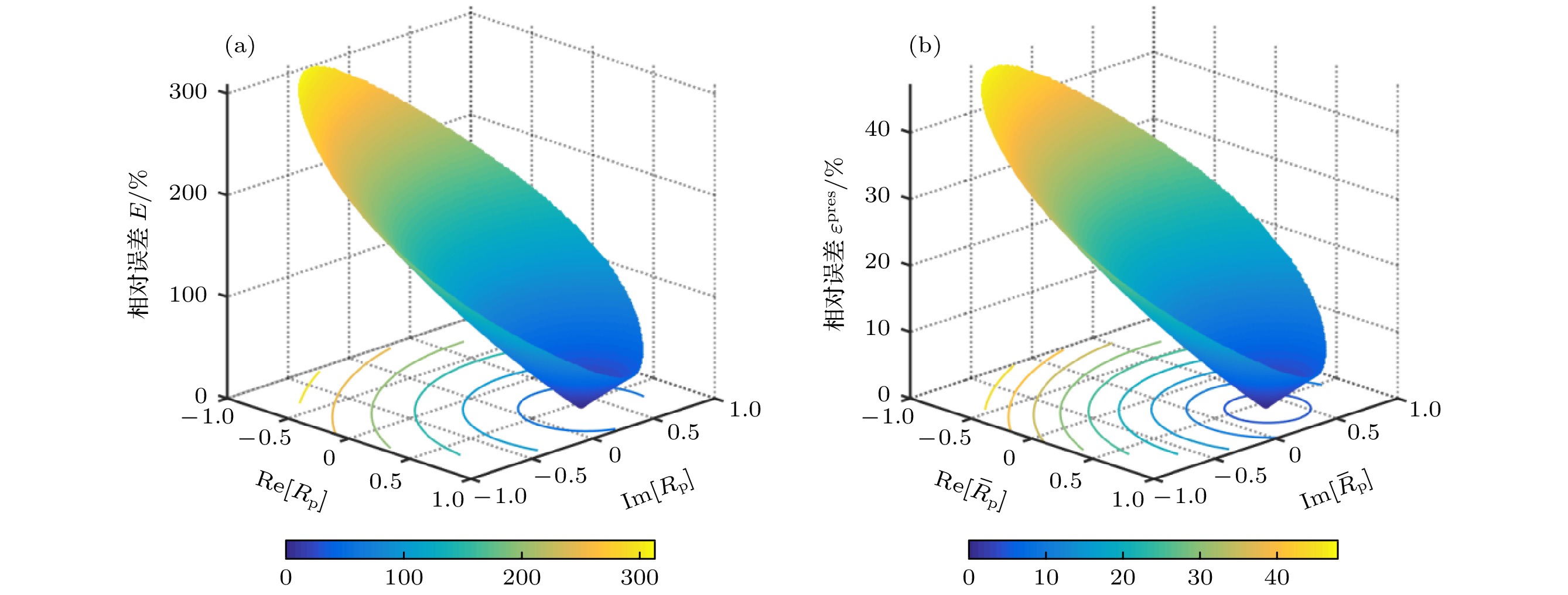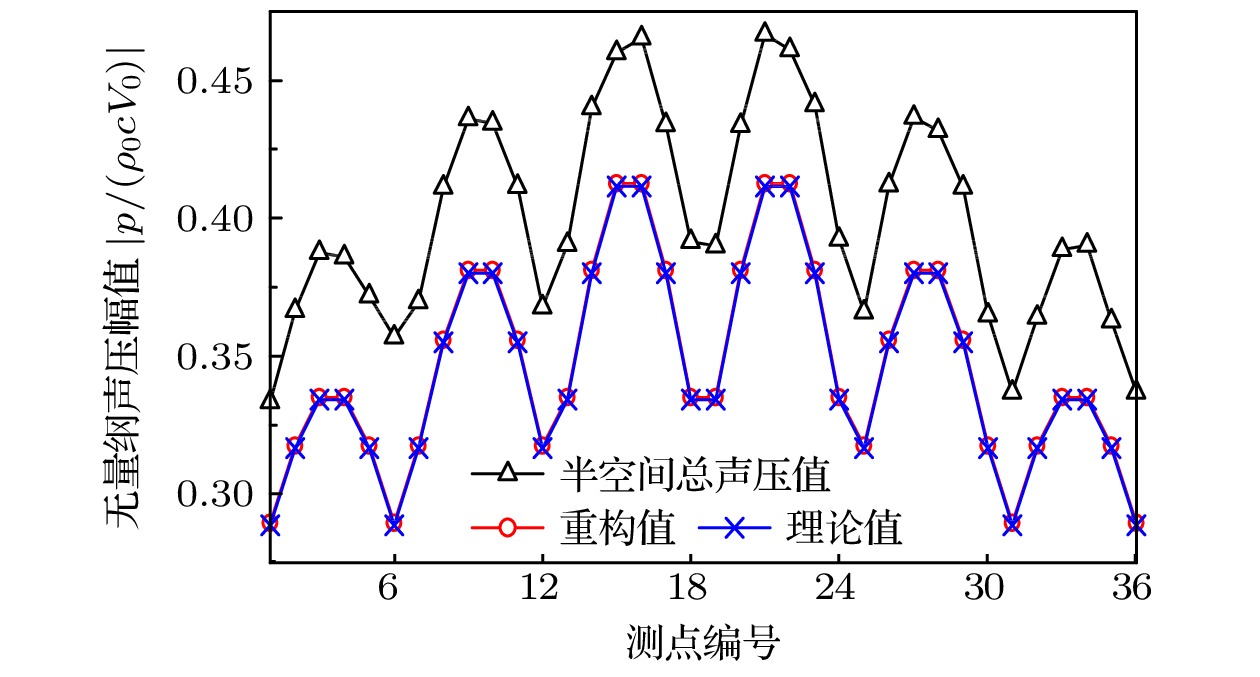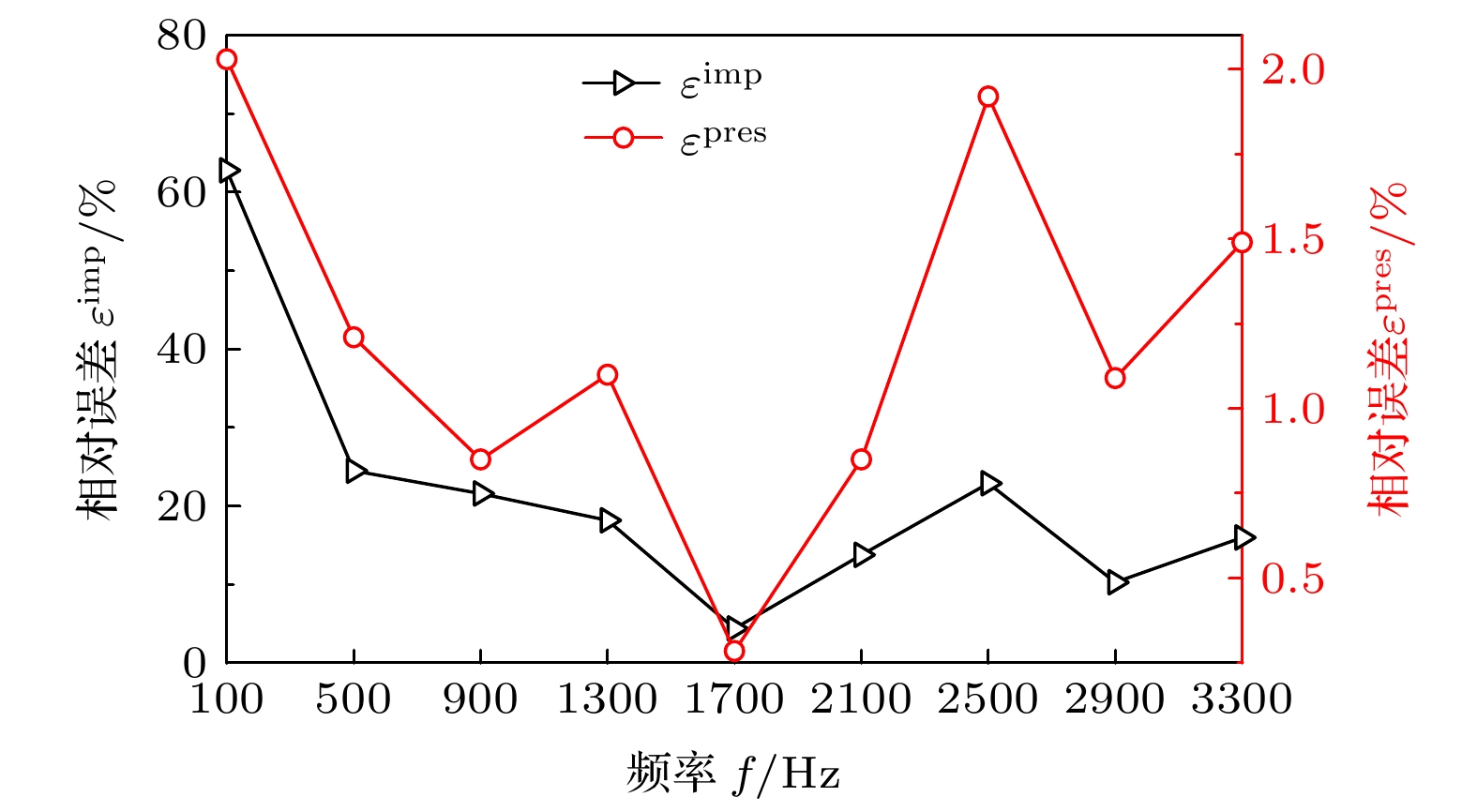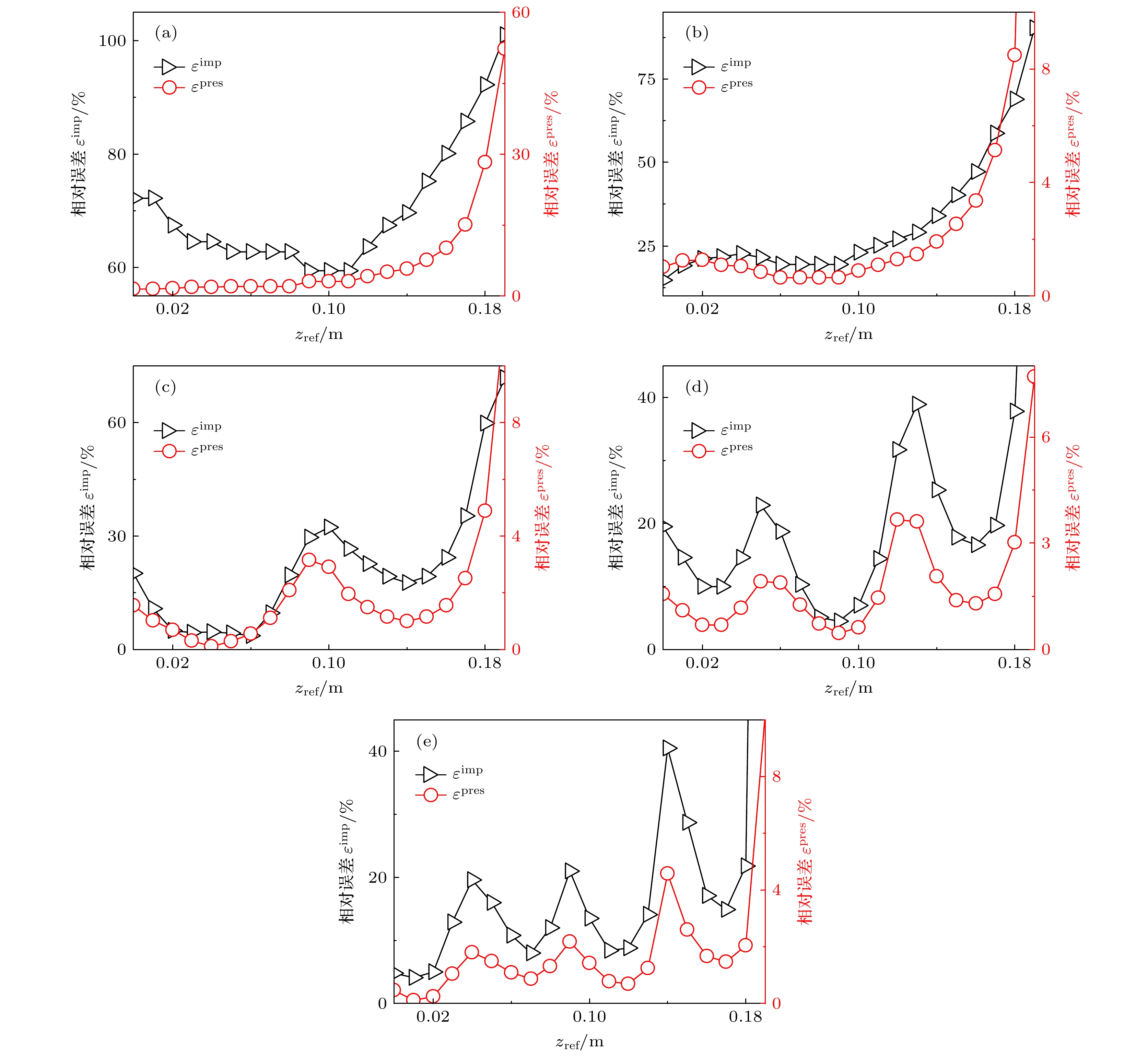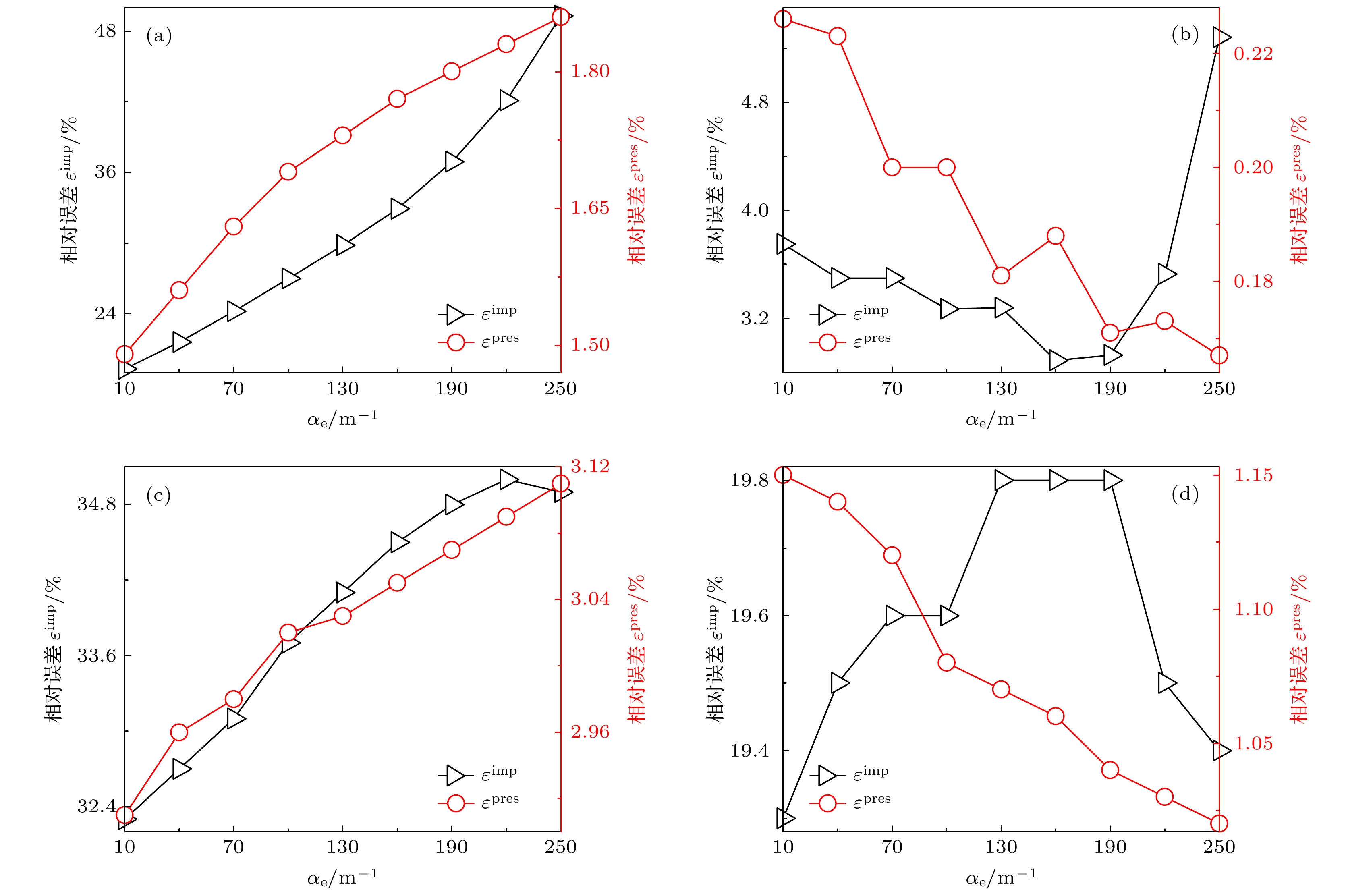-
When implementing the reconstruction of the sound field radiated directly from a source located in a half-space, the half-space basis functions need to be formulated with boundary impedance as a parameter. The boundary impedance is usually obtained via in situ acoustic impedance measurement techniques. In a reconstruction method based on expansion in half-space spherical wave basis functions, a hologram surface and a single reference microphone placed in the near-field are used to collect sound pressures. The sound pressure at the reference microphone is first reconstructed and the error of the reconstructed pressure relative to the measured pressure is then calculated. The sound pressure reflection coefficient corresponding to the minimum error is chosen as the estimated value of the reflection coefficient at each of the measurement points. Thus, this method is applicable to reconstructing the directly radiated sound pressures without knowledge of the boundary impedance, without the in situ acoustic impedance measurements necessary for conventional methods. The purpose of this work is to discuss the various parameters affecting the accuracy of reconstruction. Moreover, the boundary impedance is reconstructed based on the estimation of the reflection coefficient. In this way, an acoustic impedance measurement technique implemented via the near-field acoustical holography is proposed. Taking the source to be spherical, numerical simulations are conducted to verify the proposed method of reconstructing the boundary impedance and the directly radiated sound pressures. The influences of reference microphone coordinates, the effective flow resistivity of the boundary, and the rate of decrease of porosity with depth of the boundary on the accuracy of reconstruction are quantitatively analyzed.
-
Keywords:
- half-space /
- boundary impedance /
- reflection coefficient /
- near-field acoustical holography
[1] Wu S F 2008 J. Acoust. Soc. Am. 124 2680
 Google Scholar
Google Scholar
[2] 威廉姆斯 E G 著 (卢奂采 译) 2016 傅里叶声学: 声辐射与近场声全息 (北京: 清华大学出版社) 第152—170页
Williams E G (translated by Lu H C) 2016 Fourier Acoustics: Sound Radiation and Nearfield Acoustical Holography (Beijing: Tsinghua University Press) pp152–170 (in Chinese)
[3] Luo Z W, Comesana D F, Zheng C J, Bi C X 2019 J. Sound Vib. 439 43
 Google Scholar
Google Scholar
[4] Lu H, Wu S F 2009 J. Acoust. Soc. Am. 125 1538
 Google Scholar
Google Scholar
[5] Shi Z, Xiang Y, Lu J, Wang Y, Zhang Y 2021 AIP Adv. 11 075220
 Google Scholar
Google Scholar
[6] Zea E, Arteaga I L 2016 J. Sound Vib. 380 129
 Google Scholar
Google Scholar
[7] Zea E, Arteaga I L 2019 Appl. Acoust. 149 181
 Google Scholar
Google Scholar
[8] Zhao X, Wu S F 2005 J. Acoust. Soc. Am. 117 555
 Google Scholar
Google Scholar
[9] Bi C X, Jing W Q, Zhang Y B, Lin W L 2017 J. Sound Vib. 386 149
 Google Scholar
Google Scholar
[10] Bi C X, Chen X Z, Zhou R, Chen J 2007 ASME J. Vib. Acoust. 129 323
 Google Scholar
Google Scholar
[11] 毕传兴, 陈心昭, 陈剑 2004 物理学报 53 4268
 Google Scholar
Google Scholar
Bi C X, Chen X Z, Chen J 2004 Acta Phys. Sin. 53 4268
 Google Scholar
Google Scholar
[12] Pan S W, Jiang W K, Zhang H B, Xiang S 2014 J. Acoust. Soc. Am. 136 1744
 Google Scholar
Google Scholar
[13] Pan S W, Jiang W K, Xiang S, Liu X J 2014 Wave Motion 51 1273
 Google Scholar
Google Scholar
[14] Brandão E, Lenzi A, Paul S 2015 Acta Acust. United Ac. 101 443
 Google Scholar
Google Scholar
[15] Tamura M 1990 J. Acoust. Soc. Am. 88 2259
 Google Scholar
Google Scholar
[16] Hald J, Song W, Haddad K, Jeong C, Richard A 2019 Appl. Acoust. 143 74
 Google Scholar
Google Scholar
[17] Richard A, Fernandez-Grande E 2019 J. Acoust. Soc. Am. 146 501
 Google Scholar
Google Scholar
[18] Dupont S, Melon M, Berry A 2020 J. Acoust. Soc. Am. 147 3613
 Google Scholar
Google Scholar
[19] Zhou D, Lu H, McFarland D M, Xiao Y 2020 J. Theor. Comput. Acous. 28 2050019
 Google Scholar
Google Scholar
[20] 周达仁, 肖永雄, 卢奂采 2021 声学学报 46 321
 Google Scholar
Google Scholar
Zhou D R, Xiao Y X, Lu H C 2021 Acta Acust. 46 321
 Google Scholar
Google Scholar
[21] Morse P M, Ingard K U 1968 Theoretical Acoustics (New York: McGraw-Hill) pp370–371
[22] Attenborough K 1992 J. Acoust. Soc. Am. 92 418
 Google Scholar
Google Scholar
-
图 1 半空间声场示意图 (a)声源、传声器阵列和阻抗边界的布置; (b)声源几何中心及其关于边界的镜像点与场点、阻抗边界之间的几何关系
Figure 1. Schematic of the half-space sound field: (a) Setup of the source, the microphone array and the impedance boundary; (b) geometric relationship between the geometric center of the source, the mirror point, the field point and the impedance boundary.
图 4 相对误差的曲面图 (a)误差E随反射系数
${R_{\rm p}}$ 变化的分布; (b)误差${\varepsilon ^{{\text{pres}}}}$ 随反射系数均值${\bar R_{\rm p}}$ 变化的分布Figure 4. Surface plot of the relative error: (a) The error E versus reflection coefficient
${R_{\rm p}}$ ; (b) the error${\varepsilon ^{{\text{pres}}}}$ versus mean value of the reflection coefficient${\bar R_{\rm p}}$ .图 6 声阻抗率重构的相对误差
${\varepsilon ^{{\text{imp}}}}$ 和声源直接辐射声压重构的相对误差${\varepsilon ^{{\text{pres}}}}$ 随频率f的变化曲线Figure 6. Relative error of the reconstructed specific acoustic impedance
${\varepsilon ^{{\text{imp}}}}$ and the relative error of the reconstructed sound pressure${\varepsilon ^{{\text{pres}}}}$ radiated directly from the source versus frequency f.图 7 声阻抗率重构的相对误差
${\varepsilon ^{{\text{imp}}}}$ 和声源直接辐射声压重构的相对误差${\varepsilon ^{{\text{pres}}}}$ 随参考传声器坐标${z_{{\text{ref}}}}$ 的变化曲线 (a)$f = $ $ 100{\kern 1 pt} {\kern 1 pt} {\kern 1 pt} {\kern 1 pt} {\text{Hz}}$ ; (b)$f = 900{\kern 1 pt} {\kern 1 pt} {\kern 1 pt} {\kern 1 pt} {\text{Hz}}$ ; (c)$f = 1700{\kern 1 pt} {\kern 1 pt} {\kern 1 pt} {\kern 1 pt} {\text{Hz}}$ ; (d)$f = 2500{\kern 1 pt} {\kern 1 pt} {\kern 1 pt} {\kern 1 pt} {\text{Hz}}$ ; (e)$f = 3300{\kern 1 pt} {\kern 1 pt} {\kern 1 pt} {\kern 1 pt} {\text{Hz}}$ Figure 7. Relative error of the reconstructed specific acoustic impedance
${\varepsilon ^{{\text{imp}}}}$ and the relative error of the reconstructed sound pressure${\varepsilon ^{{\text{pres}}}}$ radiated directly from the source versus coordinate of the reference microphone${z_{{\text{ref}}}}$ : (a)$f = 100{\kern 1 pt} {\kern 1 pt} {\kern 1 pt} {\kern 1 pt} {\text{Hz}}$ ; (b)$f = 900{\kern 1 pt} {\kern 1 pt} {\kern 1 pt} {\kern 1 pt} {\text{Hz}}$ ; (c)$f = 1700{\kern 1 pt} {\kern 1 pt} {\kern 1 pt} {\kern 1 pt} {\text{Hz}}$ ; (d)$f = 2500{\kern 1 pt} {\kern 1 pt} {\kern 1 pt} {\kern 1 pt} {\text{Hz}}$ ; (e)$f = 3300{\kern 1 pt} {\kern 1 pt} {\kern 1 pt} {\kern 1 pt} {\text{Hz}}$ .图 8 声阻抗率重构的相对误差
${\varepsilon ^{{\text{imp}}}}$ 和声源直接辐射声压重构的相对误差${\varepsilon ^{{\text{pres}}}}$ 随边界参数${\sigma _{\text{e}}}$ 的变化曲线 (a)${z_{{\text{ref}}}} = 0{\kern 1 pt} $ ; (b)${z_{{\text{ref}}}} = $ $ 0.05{\kern 1 pt} {\kern 1 pt} {\kern 1 pt} {\kern 1 pt} {\text{m}}$ ; (c)${z_{{\text{ref}}}} = 0.10{\kern 1 pt} {\kern 1 pt} {\kern 1 pt} {\text{m}}$ ; (d)${z_{{\text{ref}}}} = 0.15{\kern 1 pt} {\kern 1 pt} {\kern 1 pt} {\text{m}}$ Figure 8. Relative error of the reconstructed specific acoustic impedance
${\varepsilon ^{{\text{imp}}}}$ and the relative error of the reconstructed sound pressure${\varepsilon ^{{\text{pres}}}}$ radiated directly from the source versus boundary parameter${\sigma _{\text{e}}}$ : (a)${z_{{\text{ref}}}} = 0{\kern 1 pt} $ ; (b)${z_{{\text{ref}}}} = 0.05{\kern 1 pt} {\kern 1 pt} {\kern 1 pt} {\text{m}}$ ; (c)${z_{{\text{ref}}}} = 0.10{\kern 1 pt} {\kern 1 pt} {\kern 1 pt} {\text{m}}$ ; (d)${z_{{\text{ref}}}} = 0.15{\kern 1 pt} {\kern 1 pt} {\kern 1 pt} {\text{m}}$ .图 9 声阻抗率重构的相对误差
${\varepsilon ^{{\text{imp}}}}$ 和声源直接辐射声压重构的相对误差${\varepsilon ^{{\text{pres}}}}$ 随边界参数${\alpha _{\text{e}}}$ 的变化曲线 (a)${z_{{\text{ref}}}} = 0{\kern 1 pt} $ ; (b)${z_{{\text{ref}}}} = 0.05{\kern 1 pt} {\kern 1 pt} {\kern 1 pt} {\text{m}}$ ; (c)${z_{{\text{ref}}}} = 0.10{\kern 1 pt} {\kern 1 pt} {\kern 1 pt} {\text{m}}$ ; (d)${z_{{\text{ref}}}} = 0.15{\kern 1 pt} {\kern 1 pt} {\kern 1 pt} {\text{m}}$ Figure 9. Relative error of the reconstructed specific acoustic impedance
${\varepsilon ^{{\text{imp}}}}$ and the relative error of the reconstructed sound pressure${\varepsilon ^{{\text{pres}}}}$ radiated directly from the source versus boundary parameter${\alpha _{\text{e}}}$ : (a)${z_{{\text{ref}}}} = 0{\kern 1 pt} $ ; (b)${z_{{\text{ref}}}} = 0.05{\kern 1 pt} {\kern 1 pt} {\kern 1 pt} {\text{m}}$ ; (c)${z_{{\text{ref}}}} = 0.10{\kern 1 pt} {\kern 1 pt} {\kern 1 pt} {\text{m}}$ ; (d)${z_{{\text{ref}}}} = 0.15{\kern 1 pt} {\kern 1 pt} {\kern 1 pt} {\text{m}}$ . -
[1] Wu S F 2008 J. Acoust. Soc. Am. 124 2680
 Google Scholar
Google Scholar
[2] 威廉姆斯 E G 著 (卢奂采 译) 2016 傅里叶声学: 声辐射与近场声全息 (北京: 清华大学出版社) 第152—170页
Williams E G (translated by Lu H C) 2016 Fourier Acoustics: Sound Radiation and Nearfield Acoustical Holography (Beijing: Tsinghua University Press) pp152–170 (in Chinese)
[3] Luo Z W, Comesana D F, Zheng C J, Bi C X 2019 J. Sound Vib. 439 43
 Google Scholar
Google Scholar
[4] Lu H, Wu S F 2009 J. Acoust. Soc. Am. 125 1538
 Google Scholar
Google Scholar
[5] Shi Z, Xiang Y, Lu J, Wang Y, Zhang Y 2021 AIP Adv. 11 075220
 Google Scholar
Google Scholar
[6] Zea E, Arteaga I L 2016 J. Sound Vib. 380 129
 Google Scholar
Google Scholar
[7] Zea E, Arteaga I L 2019 Appl. Acoust. 149 181
 Google Scholar
Google Scholar
[8] Zhao X, Wu S F 2005 J. Acoust. Soc. Am. 117 555
 Google Scholar
Google Scholar
[9] Bi C X, Jing W Q, Zhang Y B, Lin W L 2017 J. Sound Vib. 386 149
 Google Scholar
Google Scholar
[10] Bi C X, Chen X Z, Zhou R, Chen J 2007 ASME J. Vib. Acoust. 129 323
 Google Scholar
Google Scholar
[11] 毕传兴, 陈心昭, 陈剑 2004 物理学报 53 4268
 Google Scholar
Google Scholar
Bi C X, Chen X Z, Chen J 2004 Acta Phys. Sin. 53 4268
 Google Scholar
Google Scholar
[12] Pan S W, Jiang W K, Zhang H B, Xiang S 2014 J. Acoust. Soc. Am. 136 1744
 Google Scholar
Google Scholar
[13] Pan S W, Jiang W K, Xiang S, Liu X J 2014 Wave Motion 51 1273
 Google Scholar
Google Scholar
[14] Brandão E, Lenzi A, Paul S 2015 Acta Acust. United Ac. 101 443
 Google Scholar
Google Scholar
[15] Tamura M 1990 J. Acoust. Soc. Am. 88 2259
 Google Scholar
Google Scholar
[16] Hald J, Song W, Haddad K, Jeong C, Richard A 2019 Appl. Acoust. 143 74
 Google Scholar
Google Scholar
[17] Richard A, Fernandez-Grande E 2019 J. Acoust. Soc. Am. 146 501
 Google Scholar
Google Scholar
[18] Dupont S, Melon M, Berry A 2020 J. Acoust. Soc. Am. 147 3613
 Google Scholar
Google Scholar
[19] Zhou D, Lu H, McFarland D M, Xiao Y 2020 J. Theor. Comput. Acous. 28 2050019
 Google Scholar
Google Scholar
[20] 周达仁, 肖永雄, 卢奂采 2021 声学学报 46 321
 Google Scholar
Google Scholar
Zhou D R, Xiao Y X, Lu H C 2021 Acta Acust. 46 321
 Google Scholar
Google Scholar
[21] Morse P M, Ingard K U 1968 Theoretical Acoustics (New York: McGraw-Hill) pp370–371
[22] Attenborough K 1992 J. Acoust. Soc. Am. 92 418
 Google Scholar
Google Scholar
Catalog
Metrics
- Abstract views: 5795
- PDF Downloads: 76
- Cited By: 0














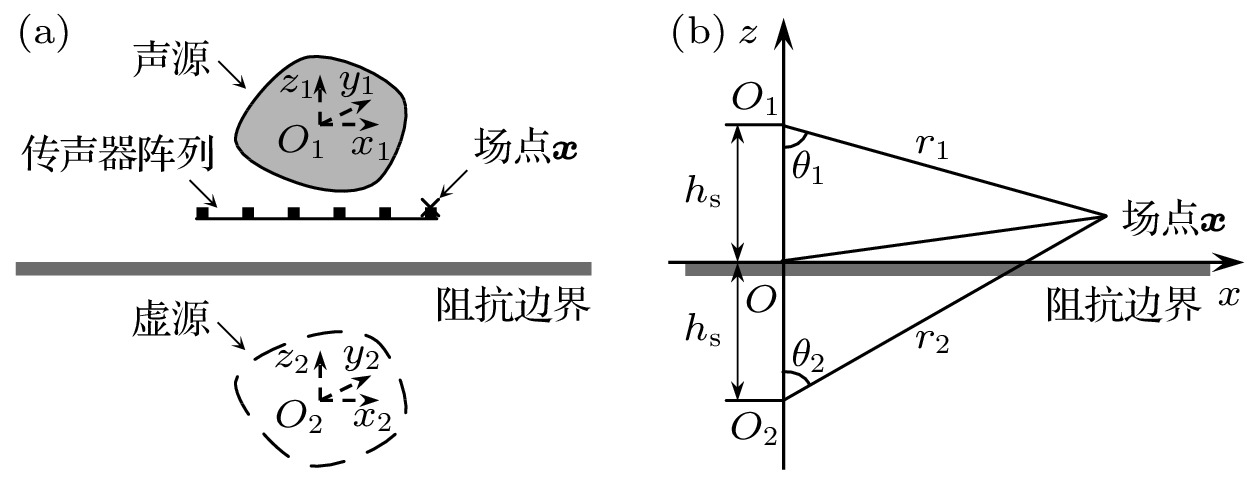
 DownLoad:
DownLoad:


